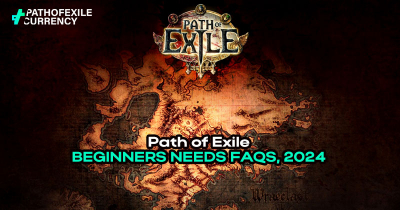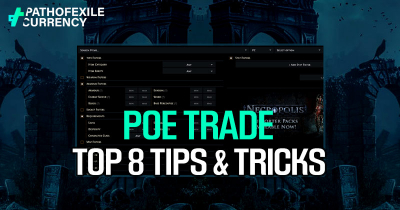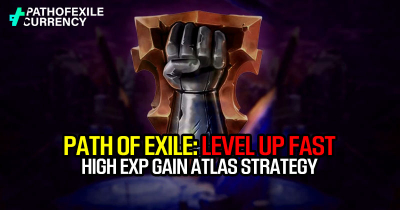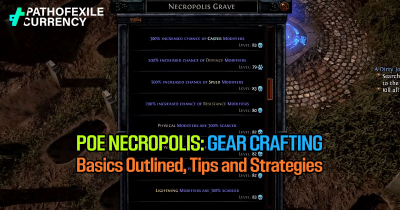Path of Exile New Player Guide, Tips and Tricks | Updated 2024
- Jackson
- Share
- Path of Exile
- 07/05/24
- 2843
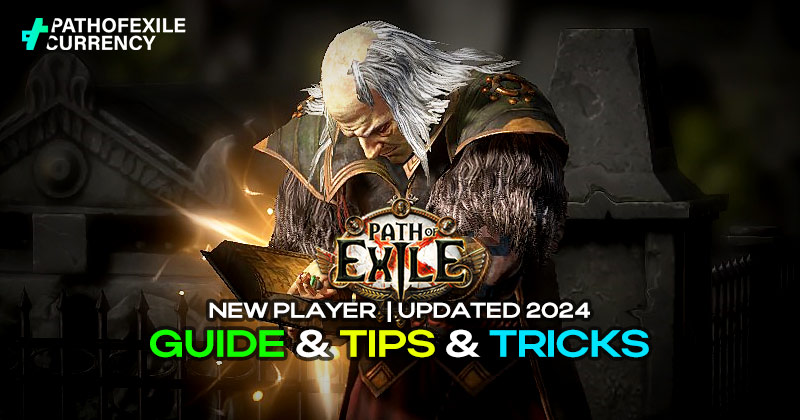
Path of Exile is an intricate action role-playing game that can be daunting for beginners. Even so, once you have learned the ropes and obtained some knowledge about Wraeclast, it becomes a captivating experience. Our guide will offer you vital information such as those on leagues, classes, ascendancies as well as why external resources are important among others!
- Leagues
- Classes & Ascendancies
- Must-Haves
- First Steps
- Gems
- Action Bar
- Items
- Equipment
- Currency Items
- Creating Bench
- Vendor Recipes
- Passive Tree
- Damage
- Defense
- Ailments
- Auras & Reservation
- Mana Cost
- Hideout & Trading Tips
- Keywords
- Helpful Resources
↖ Leagues
The first thing you'll be required to do when creating a new character is choosing a league. Leagues are essentially separate realms within the game world. There are 2 main types of leagues: standard which is permanent and temporary leagues which last for 3-4 months each before rotating out.
Temporary leagues provide fresh starts and feature unique challenges alongside rewards thus should be considered by newbies. Furthermore, at the end of every league cycle; all progress made in that particular league gets transferred over to standard thus no time invested goes into waste.
Each league has its own hardcore and softcore version. Your character gets moved to standard whenever they die in any hardcore league making it mandatory for them to start anew from scratch again but not in softcore where death isn't permanent hence recommended for starters who need to get used with mechanics themselves without being under too much pressure.

Besides there being an optional mode called Solo Self-Found (SSF) that disables player-to-player trading or grouping up with other players; most people still play on the softcore trade league because this allows them trade items back forth between one another thereby making life easier when compared against having nothing like what happens during SSF even though most won't take it seriously especially considering how difficult being self-sufficient can turn out to be.
↖ Classes & Ascendancies
PoE has seven classes: Marauder, Ranger, Witch, Duelist, Templar, Shadow and Scion (unlocked after Act 3). Each class starts at a different point on the passive skill tree. But the most important decision is which Ascendancy to choose at the end of Act 3.
Ascendancies are sub-classes that greatly affect how you play. They provide unique bonuses and playstyles for specific builds. It's important to know what Ascendancies are available early on. Here's a quick look at each class' Ascendancies:
| Marauder |
|
| Ranger |
|
| Witch |
|
| Duelist |
|
| Templar |
|
| Shadow |
|
| Scion | Ascendant (unique features from other ascendancies) |
New players should follow a build guide for their first character. Look for a league starter build — these are generally easy to level with and require minimal gear. Also, keep in mind that build guides will often reference the Ascendancy and main skill, rather than the class itself. This will give you a good foundation as you start learning more about PoE.
↖ Must-Haves
Before diving into the game there are three things outside of it that will make your Path of Exile 2024 experience much smoother.
1.) Loot Filter:
A loot filter is an essential tool to customize appearance and sound of item drops in order to hide irrelevant items and highlight valuable ones so that you don't waste time looking at trash items but also don't leave behind anything good by accident. Visit FilterBlade to get yourself a loot filter; make sure to tailor it to your preferences and select appropriate league + strictness for optimal experience.
2.) Awakened PoE Trade:
This third party application is priceless when pricing items since it allows you to quickly check their value without having to alt-tab out of game onto external trade websites which can be slow or annoying sometimes especially if they have pop up ads etc… With Awakened PoE Trade you can customize search parameters which helps determine accurate prices so trading becomes more efficient and profitable.
3.) Path of Building (PoB):
Path of Building program is essential for planning and simulating character builds. It lets you import build guides, analyze character stats, optimize skill gems and gear; everything you need to do whether following a build guide or making your own.
↖ First Steps
When beginning the game, it is important to familiarize yourself with mechanics and resources so that you can lay a strong foundation for your journey through Wraeclast.
- Read Everything: Make sure to read all in-game information like character attributes (strength, dexterity, intelligence) and what they do. Also read about how they affect different characters by hovering over them. Afterward, consult guides such as PoE Wiki or any other website/blog where you can find detailed explanations about game systems and concepts.
- Use PoE Wiki: This site contains most basic answers players might need while playing Path of Exile. You can look up anything from stat values on items or skills to sources of those items/skills themselves – everything necessary for understanding the game better.
↖ Gems
There are two main types of PoE gems: active skill gems and support gems. Active skill gems grant players spells or skills whereas support gems modify these abilities by adding more damage etc.; e.g., Faster Attacks makes your character attack faster while Added Lightning Damage gives extra electrical power to each hit dealt.
Let's take"Freezing Pulse" as an example gem. It has tags that tell us some things about this skill which must be understood when planning supports for it: whether it's an attack or spell; if it deals cold damage (type) AOE/projectile type of a spell etc.. For proper scaling through supports one should know what kind of things go well with those tags.
Note: Every time you socket a support gem into a skill, there will be an icon displayed beside the action bar which represents this specific interaction between both gems used together – so keep eye on them! Other than icons changing numbers too (cast speed DPS).
Additional considerations for modifying skills lie in base stats such as mana cost per level, cast/attack time crit chance added damage effectiveness…etc. Knowing all these numbers will help when deciding what to do with one's abilities.
As you gain experience in the game, so does your equipped skill gems – they can level up too. As a gem levels up, it demands higher item requirements (attribute or equipment wise) from player's build. If you lack necessary stats at early stages of character development, hold back on leveling certain gems till later when meeting prerequisites becomes easier for example.
Also each skill gem has its own description which gives more information about how it works and interacts with other skills/mechanics within game itself; so always read them!
↖ Action Bar
When starting, one must master the action bar for smooth gameplay. Here are some tips to help optimize how you use it:
- Change Default Attack: Swap the default attack for"move only" command. This will stop accidental attacks when trying to move your character around during combat scenarios, greatly improving control.
- Set Up Active Skills: For active skill gems select"always attack without moving" except for Dash skill which should be set on another key so it can function properly by dashing backwards when enabled. In this way, your character will attack, leap or cast abilities without any need to move from one place to another which saves time and increases overall control.
- Secondary Action Bars: Pressing control reveals a secondary action bar where keys can be rebound according to personal preference – whether it is modifying hotkeys or rearranging layout use this feature so that the action bar fits best with your playstyle.
- Customizing weapon sets: Remember that each weapon set has its own separate layout on the action bars – if you have multiple weapon sets equipped and switch between them, changes made on other bars may not carry over so make sure all actions are customized per set to maximize efficiency while playing the game.
↖ Items
PoE items fall under two main categories – Equipment and Currency items.

↖ Equipment
This category includes armor, weapons and other modifiables; they come in four rarities:
- Normal Items (white): These are base items like chest armors or wands providing basic stats with an item level determining potential modifiers they can get.
- Magic Items (blue): They have up to two extra modifiers and can be easily modified/removed/added; but don't possess implicit mods.
- Rare Items (yellow): They can have a max number of three prefixes as well as three suffixes making them highly customizable options.
- Unique Items (brown or orange): Every unique item comes with specific modifiers that only exist on that particular item and cannot be crafted onto any other piece.
Modifiers:
Understanding what modifiers are is key to effective item customization – they can either be implicit or explicit while having different tiers indicating their strength; also remember to look at the item level which determines possible mods an item can acquire.
- Implicit Mods: These are inherent properties of the item base and do not change regardless of rarity.
- Explicit Mods: Magic/rare items have them, can easily modify/add/remove these types of mods.
Local vs Global Modifiers:
This is particularly important when dealing with weapons/jewelry;
- Local Modifiers: They apply specifically to the item itself but only affect attacks/skills using the base damage of such items.
- Global Modifiers: Apply more broadly impacting various aspects beyond just one specific piece.
↖ Currency Items
PoE Currency Items are the foundations for trade and crafting. They empower players to enhance their items and transact with others. Knowing the various types of currency items and what they do is essential for new players.
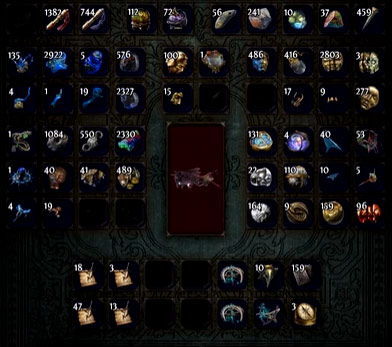
- Orbs of Transmutation add one or two random mods, turning normal (white) items into magic (blue) items.
- Orbs of Alteration re-roll different mods on magic items from the available pool.
- Collecting shards lets you craft these orbs.
- Orbs of Augmentation grant an additional mod to a magic item
- Regal Orbs adds one prefix or suffix to a magic item transforming it into a rare item.
- Orb of Alchemy Changes normal item into rare with random modifiers.
- Chaos Orb Reforges a rare item with new random ones replacing its prefixes and suffixes.
- Exalted Orb Adds random affixes to rare items .
- Divine Orb Randomly changes the values of explicit mods on gear.
- Mirror of Kalandra is extremely rare and valuable currency that can be used to create copies of the best rare items in the game. It's worth mentioning that mirrored copies cannot be modified further.
- Quality Improvement Currency: This includes Blacksmith's Whetstones, Armor Scraps, Glassblower's Baubles, Gemcutter's Prisms, Cartographer's Chisels among others which are used for improving quality on different types of items as well as maps.
- Socket Modification Currency: Jewelers/Fusings/Chromatics – these currencies help change number/color combo for sockets on an item respectively; useful when trying out new setups without having enough gear yet!
- Implicit Modifier Currency: Blessed and Sacred Orbs are used for rerolls of implicit mods while Scouring Orb removes explicit ones from items.
- Corrupting & Respec Currency: Vaal Orbs can be quite interesting as they corrupt items either making them more powerful by adding implicit mods or completely useless. Orb Of Regret lets you respec passive tree and Orb Of Unmaking endgame atlas passive tree.
- Endgame Currency: Sextants, Harbinger orbs, Horizon orbs etc. Sextants modify maps in Atlas of Worlds; Harbingers may drop additional currency shards when slain while horizon allows changing location of a map on the atlas among others.
↖ Creating Bench
PoE crafting bench are unlocked through recipes that can be found during the campaign, through map progression, and by interacting with the Betrayal mechanic. Look for prefixes such as life on Armor and jewelry, movement speed on boots, and damage on weapons. Also prioritize crafting resistances to cap them at 75%.
When picking up items, press"alt" to identify mods as prefixes or suffixes. Use the bench craft to improve items. Magic flasks should not be ignored; rolling good mods on them is very important. Act Four beastcrafting can give flask mods like removing/being immune to bleeding.
↖ Vendor Recipes
PoE vendor recipes that can result in useful outcomes. Selling specific items to a vendor grants valuable rewards. For instance, transmutations, alterations, blacksmith's whetstones and armor scraps yield wisdom scrolls. Chromatic recipe: vendoring an item with linked red/green/blue sockets will return chromatic orb.
For gems, if you overlevel a gem (and now cannot use it because of attribute requirements) – you can de-level it using orbs of regret/scouring / There are also weapon/chaos recipes which require a full rare set of items.
↖ Passive Tree
All classes share the same Passive Skill Tree in Path of Exile . Your starting position on the tree will depend on your choice of class. Small nodes grant passive bonuses such as attributes, damage increases or life boosts; Notables (the big nodes) offer more powerful bonuses so planning your build around these is essential.
Clusters (also known as Wheels) are groups of passives that are located together on the tree. Once you allocate a notable passive within a wheel – Mastery passives become available for selection anywhere within that wheel (Mastery points are refundable).
Keystones are game-changing passives that drastically change character mechanics. For example: Ancestral Bond keystone allows you to summon an additional Totem that deals damage for you.
The complexity of the Passive Tree makes it highly recommended to follow a league starter build guide on your first character. Tools like Path of Building can help you plan your passive tree in advance and calculate damage outputs; Orb of Regret or refund points from campaign side quests can be used to correct/change passives.
↖ Damage
Creating a strong character in Path of Exile requires understanding damage scaling. The difference between additive damage increases and multipliers is important to know.
Additive damage increases raise the base damage of a skill, while total amount is what damage multipliers multiply with. They become less powerful as you get more of them, on the other hand they grow in strength with every one added.
The growth rate for scaling up damages is exponential; hence small steps bring huge results when outputting higher numbers. This game uses precise language throughout its text such that "increased damage" means additively while "more damage" denotes multiplicatively.
One thing worth mentioning here is that increased taken by enemies works like a multiplier since it debuffs an enemy rather than buffing your own attacks against them. Critical strikes, Damage over Time Multipliers (DoT), support gems, enemy resistance reduction and summoning additional minions among others are sources for more multipliers.
↖ Defense
There are a number of primary strategies to take in the interest of bolstering your character's ability to survive. It is necessary that one knows what avoidance, mitigation and recovery all mean in terms of building a tanky character which is why these defense layers must be understood. To help new players strengthen their defenses and face the challenges of this game head on, here are some tips.
Tip1. Avoidance
- Invest in attack block, evasion or spell block so you can dodge more often than not.
- Put priority on items/skills that increase your chance to dodge attacks from several foes at once without taking any damage at all.
Tip 2. Mitigation
- Try to get as much resistance against fire cold lightning and chaos damage types up until their upper limit which is 75% for each type .
- You might also want to think about getting more physical damage reduction through modifiers such as those found on gear with elemental damage conversion or even endurance charges.
- Always remember that higher resistances result into greater reduction in damages suffered hence should never be overlooked when gearing up characters.
Tip 3. Recovery
- Make sure you have various sources of life regeneration e.g., passive skills , gear etc… so that no situation leaves you without steady healing over time abilities like Vitality aura or even life flasks could work well for this purpose.
- For spells/attacks that hit fast go for life gain on hit because it allows one recover predetermined amounts of health per enemy struck during battle.
- If you deal heavy amounts of damage within short periods then consider employing life leech mechanics since they enable players regain significant portions of lost hp especially when engaged in prolonged fights against powerful opponents.
↖ Ailments
PoE introduces a variety of Ailments to characters, each associated with specific types of damage. Understanding these ailments and their remedies is key to success.
| Ailments | Description | How to Avoid? |
| Ignite | Fire damage hits can cause an elemental ailment called ignite, which deals fire damage over time. Only one ignite can affect a target at once. | To avoid being ignited, use flask modifiers that remove or provide immunity against it. Moreover, give priority to gears and passives that give chance of avoiding ignite or grant significant recovery like regeneration or life leech. |
| Shock | Shock is an elemental ailment linked to lightning damage that makes the target take increased damage. | Avoiding shock involves using flask modes, passives, and gear mods that lower chance to get shocked or lessen its effect. You can also become shock immune by employing defensive mechanisms such as Tempest Shield. |
| Freeze | Freeze entirely stops the target's action speed making them unable to move. | Preventing freeze means applying flask mods that remove or grant immunity against freezing; Stacking passives along with gear mods for 100% chance not to be frozen; Utilizing Arctic Armor buff among others. |
| Chill | Chill is a cold elemental secondary effect which reduces action speed but does not set it to zero. | The best way of avoiding chill includes chill removal flasks, immunity flasks, Auras like purity of elements Aura etc., passives on gear and modifiers that avoid or reduce its effect. |
| Bleeding | Bleeding is an attack hit physical damage over time ailment where moving targets receive triple bleed damage than stationary ones. | The steel skin guard skill helps in removing bleeding so as to mitigate its harmfulness; Also flask mods can be used for this purpose too. |
| Poison | Poison is inflicted by physical and chaos damage hits which cause chaos damage over time. Multiple poisons can affect a target simultaneously. | Focusing on chaos resistance, life recovery, pantheons, passes and gear mods helps in mitigating poison. |
↖ Auras & Reservation
PoE Auras are skills or buffs that affect you and allies nearby (including party members and minions). Although some are technically not auras, such as Arctic Armor which only affects the player and does not have the aura tag on its gem.
Auras can be activated by reserving your life or mana; this is different from costing mana. Lowering skill's mana costs will not lower the amount reserved for them. To reduce how much life/mana a skill reserves you require reservation efficiency, this means that with more reservation efficiency a single skill will take less of your Mana. More so, stacking it allows fitting in more auras or making each of them reserve less Mana so that all your abilities can be used effectively.
Some builds abuse such mechanics like Eldritch Battery Keystone, which enables using energy shield instead of Mana or use items like LIF Tap to spend life instead of Mana on spells and attacks.
↖ Mana Cost
To prevent Mana difficulties, you must manage the price of mana. When the cost per second of Mana exceeds that which you regenerate every second you will find it hard to use abilities continuously.
This can be solved by using enduring flasks of Mana that continue with their recovery action even when all your unreserved Mana has been depleted. This method ensures there is a steady recovery of Mana without depending on reactive flask usage.
There are some other things which might help deal with this problem like reducing skill's costs in terms of passive skill tree nodes, Inspiration support gems for elemental damage or crit damage skills and Betrayal mechanic where one can craft jewelry with negative mana costs.
Increasing the maximum amount of mana and its regeneration rate will also go a long way in solving this issue. You may want to spend some temporary points on mana nodes especially those around "Mana Mastery" within your skill tree so as to improve efficiency when reserving mana, regenerating it or lowering the cost associated with certain skills.
↖ Hideout & Trading Tips
The Hideout and Trading are two important mechanics for beginners to understand in order to have a good gaming experience. Below are some tips and tricks that will help you set up your hideouts faster as well as navigate through the trading system efficiently.
1. Hideout Setup
- Minimize time spent walking between Waypoint, stash, and crafting Bench by placing them close together in the Hideout.
- Customize your hideout to be comfortable since you'll spend a lot of time there.
2. Trading Etiquette
- The buyer goes to pathofexile.com trade to find an item then messages the seller to start the trade.
- Use "Direct whisper" on website to automatically message seller or copy paste it manually in-game.
- Some sellers may be busy so it requires patience when trading; sometimes you have to message multiple people until you find what you want.
- Press 'alt' while hovering over items in trade window/inventory to view count and avoid miscalculations.
- Always double-check items before accepting trade so that scamming can be avoided.
3. Stash Tabs for Trading
- Smooth trading experience can be achieved by purchasing premium stash tabs after completing campaign.
- Premium stash tabs allow others see and buy from your listed items easily by making them public.
- Cosmetics microtransactions+points for shop are given out by supporter packs which also provide stash tabs .
- Map tab, currency tab, premium tab for trading (essential) then fragment tab and quad tab for advanced organization/trading capabilities should be started with.
↖ Keywords
New players may be confused by specific terms and acronyms. For example, "recently" in a tooltip always means the last four seconds, and "low life" means 50% or less health. To learn more about these words, check out poe wiki.net for a comprehensive list of keywords commonly used in the game.
↖ Helpful Resources
External resources are essential to succeeding in Path of Exile. Here are some links worth saving:
- Filter Blade: A tool for loot filters that improve item sorting and prioritization.
- Path of Building: Plan your builds for maximum efficiency and effectiveness.
- Poe Ninja: Get an idea of the current economy, valuable items, top characters, and popular builds.
- Craft of Exile: Learn crafting techniques and item modifiers; practice crafting without using in-game resources.
- PoEB: A database with information on items, skills, monsters, bosses, etc.
Through understanding these components and making educated choices based on them As a new player you will be able to start their journey with confidence and clarity as a result of this knowledge gained from knowing these key elements..
Most Popular Posts
- Path of Exile Level Up Fast: High Exp Gain Atlas Strategy
- PoE Crafting: Top 20 Hidden Tricks and Features
- Path of Exile New Player Guide, Tips and Tricks | Updated 2024
- PoE Perandus Pact Ultimate Guide: Unlock Secrets of This Unique Jewel
- PoE Trade: Top 8 Tips and Tricks You Must Know
- PoE Currency Farming Effective Strategies | Necropolis League
Popular Category Lists
- Path of Exile / (17)




 0
0
